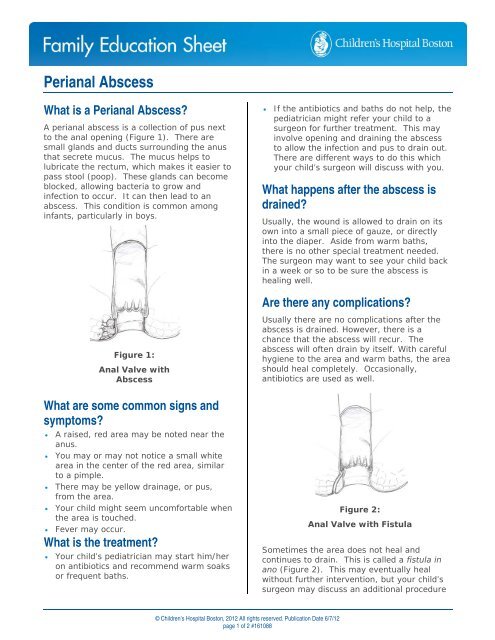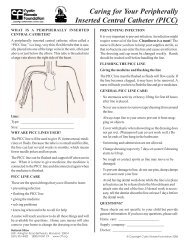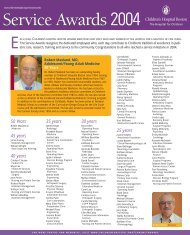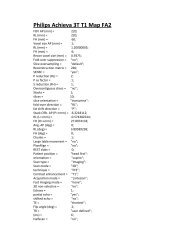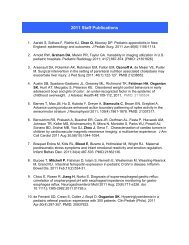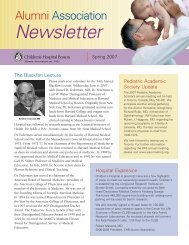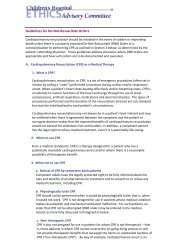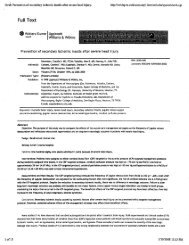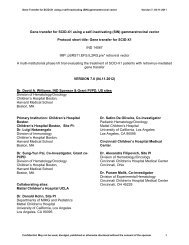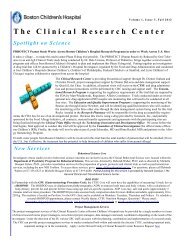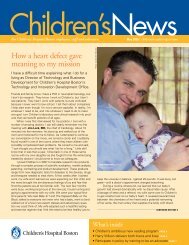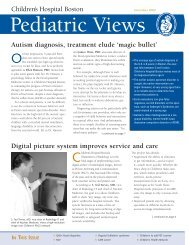Perianal Abscess - Children's Hospital Boston
Perianal Abscess - Children's Hospital Boston
Perianal Abscess - Children's Hospital Boston
You also want an ePaper? Increase the reach of your titles
YUMPU automatically turns print PDFs into web optimized ePapers that Google loves.
<strong>Perianal</strong> <strong>Abscess</strong><br />
What is a <strong>Perianal</strong> <strong>Abscess</strong>?<br />
A perianal abscess is a collection of pus next<br />
to the anal opening (Figure 1). There are<br />
small glands and ducts surrounding the anus<br />
that secrete mucus. The mucus helps to<br />
lubricate the rectum, which makes it easier to<br />
pass stool (poop). These glands can become<br />
blocked, allowing bacteria to grow and<br />
infection to occur. It can then lead to an<br />
abscess. This condition is common among<br />
infants, particularly in boys.<br />
Figure 1:<br />
Anal Valve with<br />
<strong>Abscess</strong><br />
What are some common signs and<br />
symptoms?<br />
A raised, red area may be noted near the<br />
anus.<br />
You may or may not notice a small white<br />
area in the center of the red area, similar<br />
to a pimple.<br />
There may be yellow drainage, or pus,<br />
from the area.<br />
Your child might seem uncomfortable when<br />
the area is touched.<br />
Fever may occur.<br />
What is the treatment?<br />
Your child’s pediatrician may start him/her<br />
on antibiotics and recommend warm soaks<br />
or frequent baths.<br />
© Children’s <strong>Hospital</strong> <strong>Boston</strong>, 2012 All rights reserved. Publication Date 6/7/12<br />
page 1 of 2 #161088<br />
If the antibiotics and baths do not help, the<br />
pediatrician might refer your child to a<br />
surgeon for further treatment. This may<br />
involve opening and draining the abscess<br />
to allow the infection and pus to drain out.<br />
There are different ways to do this which<br />
your child’s surgeon will discuss with you.<br />
What happens after the abscess is<br />
drained?<br />
Usually, the wound is allowed to drain on its<br />
own into a small piece of gauze, or directly<br />
into the diaper. Aside from warm baths,<br />
there is no other special treatment needed.<br />
The surgeon may want to see your child back<br />
in a week or so to be sure the abscess is<br />
healing well.<br />
Are there any complications?<br />
Usually there are no complications after the<br />
abscess is drained. However, there is a<br />
chance that the abscess will recur. The<br />
abscess will often drain by itself. With careful<br />
hygiene to the area and warm baths, the area<br />
should heal completely. Occasionally,<br />
antibiotics are used as well.<br />
Figure 2:<br />
Anal Valve with Fistula<br />
Sometimes the area does not heal and<br />
continues to drain. This is called a fistula in<br />
ano (Figure 2). This may eventually heal<br />
without further intervention, but your child’s<br />
surgeon may discuss an additional procedure
Family Education Sheet • <strong>Perianal</strong> <strong>Abscess</strong><br />
with you, which is done to open the fistula<br />
site to help it heal. This procedure is usually<br />
done in the operating room under general<br />
anesthesia.<br />
If my child needs surgery, what<br />
happens on the day of surgery?<br />
General anesthesia is used. Most children go<br />
home the same day as surgery. However,<br />
some children need to spend a night in the<br />
hospital for observation.<br />
You will meet both the surgeon and the<br />
anesthesia doctor on the day of surgery.<br />
After surgery, your child will stay in the Day<br />
Surgery Unit until he/she is ready to go<br />
home. To go home, your child must be alert<br />
and able to take fluids. Parents are welcome<br />
to stay with their child during this time.<br />
What happens after the surgery?<br />
Your child’s surgeon will give specific<br />
instructions regarding care of the wound.<br />
Pain medicine may be prescribed. It is<br />
important to give the medicine as<br />
prescribed by your doctor and nurse.<br />
Please ask your child’s doctor, nurse, nurse<br />
practitioner or pharmacist to explain any<br />
instructions that you do not understand.<br />
© Children’s <strong>Hospital</strong> <strong>Boston</strong>, 2012 All rights reserved. Publication Date 6/7/12<br />
page 2 of 2 #161088<br />
Your child’s surgeon will let you know<br />
when he/she would like to see your child<br />
for follow-up.<br />
There usually are no restrictions on activity<br />
after this surgery.<br />
When to call<br />
Call your doctor, nurse, or nurse practitioner<br />
if you see or note the following:<br />
Increased redness, swelling or tenderness<br />
around the incision site;<br />
Fever greater than 101° F;<br />
Pain that is not helped by prescribed<br />
medication.<br />
Numbers to Call<br />
Monday – Friday<br />
8:30am – 5:00pm<br />
Evenings, Nights,<br />
Weekends, and<br />
Holidays<br />
(617) 355-7780<br />
Page Operator:<br />
(617) 355-6369<br />
Ask for the surgeon<br />
on-call.<br />
A Spanish version of this education sheet is<br />
available from your provider.


